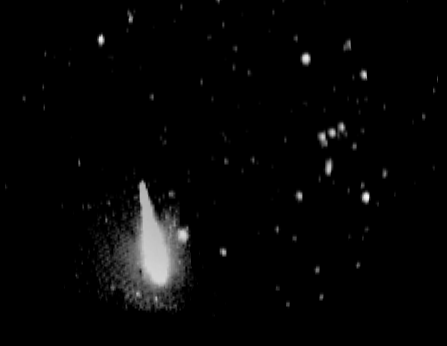Astronomy Picture of the Day
Discover the cosmos! Each day a different image or photograph of our
fascinating universe is featured, along with a brief explanation written by
a professional astronomer.
February 26, 1996

Fireball!
Credit:
Sirko Molau,
IMO,
Archenhold-Sternwarte
Explanation:
On rare but spectacular occasions,
fireballs, meteors brighter than the brightest stars, flash
through the heavens - sometimes
making audible sounds and occasionally surviving to
strike the Earth's surface. The
path of one such fireball, recorded last year in
January skies over Hannover Germany is
shown above,
the brilliant meteor easily outshining the
stars of the constellation Orion
(visible at the far right).
In fact, for this brief moment Sirius,
the brightest star in the night sky,
is overwhelmed as the image of the fireball grazes it.
This dramatic event was recorded by a
video camera observation technique
known as
MOVIE.
Interplanetary
space is littered with meteoroids,
"rocks" tens of yards in diameter and less.
Striking the Earth's atmosphere at high relative speeds,
they leave visible trails known as
meteors or, more poetically, "shooting stars".
The trails are created when the intense heat
caused by friction vaporizes them.
Fireballs can be caused
by meteroids weighing small fractions of an ounce which do not
survive to reach the ground.
Remnants of larger ones, which do reach the ground after
running this fiery gauntlet, are called meteorites.
Though fireballs are rare,
meteors are visible on any clear night of the year.
Even outside the predicted regular
meteor shower events, patient observers in dark
sky areas can see several an hour -
by just looking up!
Sightings of fireballs should be
reported.
Tomorrow's picture: X-ray Star and X-ray Moon
| Archive
| Index
| Search
| Glossary
| Education
| About APOD |




Authors & editors:
Robert Nemiroff
(GMU) &
Jerry
Bonnell (USRA).
NASA Technical Rep.:
Sherri
Calvo.
Specific rights apply.
A service of:
LHEA
at
NASA/
GSFC




